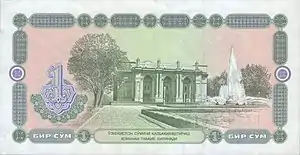Navoi Theater
The Navoi Theater (Uzbek: Alisher Navoiy nomidagi davlat akademik katta teatri, "Alisher Navoi State Academic Bolshoi Theatre")[1] is the national opera theater in Tashkent, Uzbekistan.



Overview
In 1929, amateurs of concert-ethnographic group led by M. Kari-Yakubov was established and later founded the professional theatre. In 1939 it was renamed to the Uzbek State Opera and Ballet Theatre, and in March 1948 it was united with Russian theatre and called as the State Opera and Ballet Theatre named after Alisher Navoi. Later, in 1959 the theatre obtained the status of Academic theatre and in 1966 – the status of Bolshoi Theatre,[2][3]
Designed by Alexey Shchusev,[4] the building of the theater was built in 1942-1947 and was opened to the public in November, 1947, celebrating the 500th anniversary of the birth of Alisher Navoi. During 1945–47, the Japanese prisoners of war participated in the building construction under forced labor.[5][6]
The theater has a capacity of 1,400 spectators. The main stage is 540 square meters big.
See also
References
- "Государственный Академический Большой театр имени Алишера Навои". www.gabt.uz. Retrieved 2017-10-27.
- "Tashkent theatres in Uzbekistan: History of theatres, repretoire, famous plays". www.advantour.com. Retrieved 2017-10-27.
- "History of the theatre". gabt.uz. Retrieved 2017-10-27.
- "Alisher Navoi Theatre & Opera in Tashkent | Caravanistan". Caravanistan. Retrieved 2017-10-27.
- Japanese detainees and the Navoi Theater
- McLeod, Calum (2010). Uzbekistan : the golden road to Samarkand. Mayhew, Bradley. (7th ed.). Hong Kong: Odyssey. p. 99. ISBN 9789622178236. OCLC 751737081.
.jpg.webp)